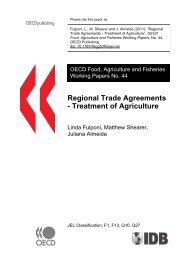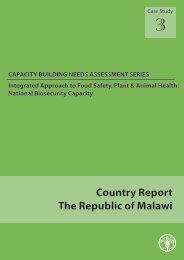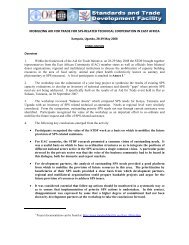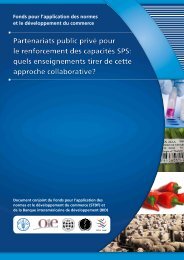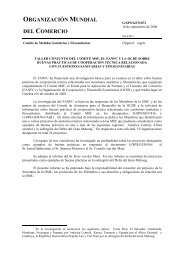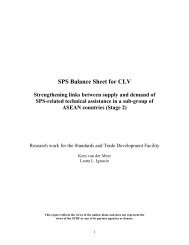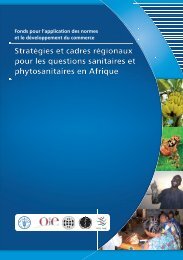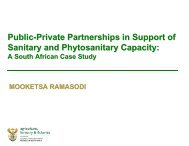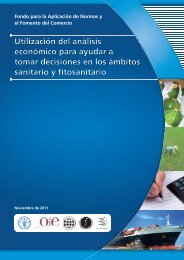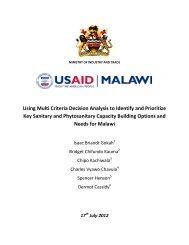SPS-Related Capacity Evaluation Tools - Standards and Trade ...
SPS-Related Capacity Evaluation Tools - Standards and Trade ...
SPS-Related Capacity Evaluation Tools - Standards and Trade ...
Create successful ePaper yourself
Turn your PDF publications into a flip-book with our unique Google optimized e-Paper software.
Sector-specific <strong>Tools</strong><br />
IPPC Phytosanitary <strong>Capacity</strong> <strong>Evaluation</strong> (PCE) Tool<br />
The IPPC has developed, <strong>and</strong> refined over several years of implementation, a management tool (The PCE,<br />
or Phytosanitary <strong>Capacity</strong> <strong>Evaluation</strong>), which is designed to help a country to identify both strengths <strong>and</strong><br />
gaps in its existing <strong>and</strong> planned phytosanitary systems.<br />
The PCE was one of the first <strong>SPS</strong>-related situation analysis methods developed. Initially, it consisted of a<br />
paper based set of questionnaires concerning technical aspects of the plant health system of a country. At the<br />
request of the IPPC, the New Zeal<strong>and</strong> Government, under its Overseas Development Assistance programme,<br />
funded the initial development of the PCE as a web version in 1999 to assess national phytosanitary capacity<br />
needs <strong>and</strong> priorities. Following pilot testing in six countries (Cook Isl<strong>and</strong>s, Fiji, Solomon Isl<strong>and</strong>s, Indonesia,<br />
Bangladesh <strong>and</strong> Viet Nam), the tool was revised, updated <strong>and</strong> exp<strong>and</strong>ed. It subsequently became known<br />
as the PCE Tool <strong>and</strong> in 2001 the Interim Commission on Phytosanitary Measures (ICPM) agreed that the IPPC<br />
Secretariat should be responsible for its updating <strong>and</strong> maintenance.<br />
A major revision of the PCE Tool was released in November 2004 as a multilingual CD-ROM version which<br />
included French, Arabic <strong>and</strong> Spanish language versions.<br />
In 2006, a comprehensive review of the PCE process<br />
was carried out by the Centre for Agricultural Bioscience<br />
International (CABI) Africa <strong>and</strong> presented to the Commission<br />
on Phytosanitary Measures (CPM-2) in 2007 5 . This review<br />
noted the positive impacts of the PCE at the national level,<br />
specifically its role in supporting the identification of capacity<br />
building needs <strong>and</strong> strategic planning, identifying areas for<br />
increased budgetary allocations, emphasizing the importance<br />
of appropriate legislation, increasing awareness about the IPPC<br />
<strong>and</strong> enabling National Plant Protection Organizations (NPPOs)<br />
to present their needs more effectively to government.<br />
The main recommendations of this external review, which<br />
were discussed <strong>and</strong> endorsed by the CPM from 7 to 11 April<br />
2008, were as follows:<br />
• An overall technical assistance (TA) strategy: A phytosanitary<br />
capacity building strategy is required <strong>and</strong>, following<br />
CPM-3, an Open Ended Working Group should be established<br />
to develop a draft strategy <strong>and</strong> appropriate definition for<br />
capacity building to be considered by the CPM Informal<br />
Working Group on Strategic Planning <strong>and</strong> Technical<br />
Assistance (SPTA) for presentation to the CPM-4.<br />
• Future development of the PCE: The PCE should be arranged<br />
into a stratified framework so that a user may follow the<br />
tool on a modular basis, going into more detail when more<br />
assistance is needed, with provision of links to additional<br />
information <strong>and</strong> guidance. The PCE should not be linked<br />
to IICA’s Performance, Vision <strong>and</strong> Strategy (PVS) tool,<br />
recognizing that both were useful based on the intended<br />
objectives for which they were developed.<br />
• Development of other tools: Simple tools, based on<br />
spreadsheets for example, should be developed to address<br />
very specific evaluation objectives (such as modelling risks,<br />
assessing efficiency of services, cost recovery calculations,<br />
investment decision making, etc.) with due regard for cost<br />
implications.<br />
5 This report is available on the IPPC website at: https://www.ippc.int/<br />
file_uploaded/1227266857475_PCE_CABI_Assessment.pdf<br />
• Long-term considerations: An initiative on the quality of<br />
phytosanitary data (including the costs of surveys, inspection,<br />
quarantine, staff, etc.) should be launched as targeted<br />
assistance to NPPOs.<br />
All of the above systems <strong>and</strong> tools should be reviewed in<br />
order to ensure the inclusion of environmental concerns (i.e.<br />
protection of domestic plant resources) rather than strictly<br />
trade related concerns. It was noted that the process of<br />
incorporating environmental <strong>and</strong> other concerns was already<br />
in place <strong>and</strong> would be reflected more prominently in a future<br />
improved version of the PCE.<br />
In 2010, the IPPC Secretariat further revised the PCE based<br />
on the recommendations of the informal PCE Working Group<br />
<strong>and</strong> the external review by CABI Africa. As a consequence,<br />
the tool has been migrated into a “web only” version. The<br />
purpose of the migration is to provide countries with a stable<br />
platform accessible through the internet <strong>and</strong> a secure area<br />
to store PCE sessions over a number of years with the ability<br />
to compare recent sessions with those done in the past. The<br />
revised PCE version sought to address the concerns identified<br />
by the external review as well as by contracting parties.<br />
?<br />
What is the scope of the PCE ?<br />
The PCE generates a snapshot of a country’s phytosanitary<br />
capacity at a particular time, as the basis for planning<br />
phytosanitary capacity building. The primary focus is to<br />
examine the capacity of NPPOs in relation to implementation<br />
of International <strong>St<strong>and</strong>ards</strong> for Phytosanitary Measures (ISPMs)<br />
<strong>and</strong> the rights, obligations <strong>and</strong> responsibilities described in<br />
the IPPC. The PCE can provide the framework for national<br />
strategic planning to prioritise activities/resources to fill gaps<br />
<strong>and</strong> enhance the effectiveness of the overall phytosanitary<br />
system. Importantly, it can also provide the framework for<br />
dialogue with donors of development aid, <strong>and</strong> thus improve<br />
the likelihood of access to further funding.<br />
14 <strong>SPS</strong>-<strong>Related</strong> <strong>Capacity</strong> <strong>Evaluation</strong> <strong>Tools</strong>



